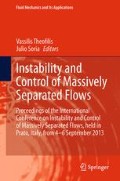Abstract
The linear global stability of an interaction between an oblique shock wave and a laminar boundary layer is carried out for various oblique shock angles. It is illustrated that such a flow acts as a noise amplifier. The least temporally damped global modes are classified into three main categories, low, medium and high frequencies. The high frequencies are localized into the attached boundary layer, the medium frequencies are associated with Kelvin–Helmholtz like structures along the shear layer and convective waves in the separated flow downstream whereas the low frequencies are driven by the interaction zone. In particular, a low frequency mode emerges which is scaled by the interaction length and the freestream velocity.
Access this chapter
Tax calculation will be finalised at checkout
Purchases are for personal use only
References
Bagheri S, Akervik E, Brandt L, Henningson DS (2009) Matrix-free methods for the stability and control of boundary layer. AIAA J 47(5):1057–1068
Degrez G, Boccadoro CH, Wendt JF (1987) The interaction of an oblique shock wave with a laminar boundary layer revisited. an experimental and numerical study. J Fluid Mech 177: 247–263
Délery J, Marvin JG (1986) Shock-wave boundary layer interactions. Technical report, AGARDograph
Guiho F, Alizard F, Robinet J-C (2013) Global stability analysis with compressible cfd solver. AIAA Paper-2013-2620
Pagella A, Rist U, Wagner S (2002) Numerical investigations of small-amplitude disturbances in a boundary layer impinging shock wave at ma = 4.8. Phys Fluids 14(7):2088–2101
Robinet J-Ch (2007) Bifurcations in shock wave / laminar boundary layer interaction: global instability approach. J Fluid Mech 578:67–94
Tullio N, Sandham ND (2012) Transitional shock-wave/boundary layer interaction behind a roughness element. In: Kontis K (ed) 28th International symposium on shock waves. Springer, Heidelberg, pp 439–445
Author information
Authors and Affiliations
Corresponding author
Editor information
Editors and Affiliations
Rights and permissions
Copyright information
© 2015 Springer International Publishing Switzerland
About this paper
Cite this paper
Guiho, F., Alizard, F., Robinet, JC. (2015). Global Instability in Shock Wave Laminar Boundary-Layer Interaction. In: Theofilis, V., Soria, J. (eds) Instability and Control of Massively Separated Flows. Fluid Mechanics and Its Applications, vol 107. Springer, Cham. https://doi.org/10.1007/978-3-319-06260-0_14
Download citation
DOI: https://doi.org/10.1007/978-3-319-06260-0_14
Published:
Publisher Name: Springer, Cham
Print ISBN: 978-3-319-06259-4
Online ISBN: 978-3-319-06260-0
eBook Packages: EngineeringEngineering (R0)

